After years of parliamentary gridlock, British voters spoke decisively in the December 12 general election. The Conservative Party led by Prime Minister Boris Johnson returned to power with a sizable majority, enabling it to move forward with Brexit by the January 31 deadline and set the domestic policy agenda for the next five years and likely beyond. The Labour Party suffered its worst defeat in modern history, with many blaming the unpopularity of leader Jeremy Corbyn. The outcome also raises questions about the constitutional future of the United Kingdom, particularly in Scotland and Northern Ireland.
What was the election result?
Conservative Party. The Conservative Party won 365 of 650 seats, giving them a solid governing majority. Its 44% vote share gives the party its highest vote total since Margaret Thatcher became prime minister in 1979. (By way of context, this is still a smaller majority than Labour Prime Minister Tony Blair enjoyed after elections in 1997, 2001, and 2005.) This will enable Johnson to implement Brexit and his domestic legislative agenda without any significant opposition for the next five years. The party will likely govern throughout the 2020s, as it is unlikely any party can overcome this deficit in a single electoral cycle. The question will be how Johnson chooses to govern, since he will be unencumbered by factions in his own party (as David Cameron was by hardline Brexiteers) or reliance on another party (as Theresa May was by Northern Ireland’s Democratic Unionist Party after the 2017 election or as Cameron was by the Liberal Democrats in his first term).
Labour Party. Despite Conservative gains, the biggest story of the election was the implosion of support for the Labour Party. It won 203 seats, the party’s worst result in 84 years. Johnson capitalized on the Brexit divide and Corbyn’s unpopularity to make significant gains in northern England and Wales, wiping out Labour’s so-called “red wall.” Notably, he flipped at least 15 seats that Labour held since World War II — including those formerly held by Labour Prime Ministers Tony Blair and Gordon Brown. Although May made inroads in these areas in 2017, she made numerous missteps during the campaign; Johnson finished the job by engaging northern England and stressing plans to finalize Brexit.
Corbyn announced that he would not lead the party into the next general election, though plans to would remain leader for a “period of reflection.” Given the anger within the party, as many blame him personally for Labour losses — rather than accept the party line of blaming Brexit — it seems unlikely he will remain for long.
Liberal Democrat Party. The Liberal Democrats also had a terrible night. Jo Swinson, who was elected party leader six months ago, lost her own seat by 149 votes to the SNP. (She held the seat since 2005, though lost it to the SNP in 2015 and regained it in 2017.) She resigned as party leader, requiring the party to find its fifth head in five years. The party retained 11 seats, comparable with its performance in the last election but fewer than they held in recent months given party-switchers. In some Remain-supporting areas, Labour and the Liberal Democrats are accusing each other of splitting the vote and enabling Tory wins. Others faulted the party’s pledge to revoke the Article 50 notification for Brexit as dissuading likely supporters.
Brexit Party. Nigel Farage’s Brexit Party received 2% of the vote, but it failed to win any of the 273 seats it contested. Johnson’s victory was helped by Farage’s decision not to challenge the 317 seats won by the Conservatives in the last election, though some results suggest the Tory win could have been even larger if Farage had stood down in all seats. Moving forward, he plans to rename his party the Reform Party and may serve as the opening act for Donald Trump at his 2020 campaign rallies.
Is Brexit happening?
Yes. In his victory speech, Johnson said: “This election means that getting Brexit done is now the irrefutable, irresistible, unarguable decision of the British people. And this this election I think we put an end to all those little miserable threats of a second referendum.”
Johnson plans to hold the Queen’s Speech, which officially opens Parliament and presents his government’s legislative agenda, on December 19. He will hold the first reading on his Brexit deal the following day, before allowing members to rest over the holidays. When Parliament returns in January, it will almost certainly ratify the Withdrawal Act (the domestic legislation implementing Brexit) in order for the U.K. to leave the EU by the January 31 deadline. After the British Parliament has passed the deal, the European Parliament is expected to follow.
Once the divorce is finalized, Johnson can begin negotiating the U.K.’s future relationship with the EU. His sizable majority empowers him to negotiate as he sees fit, yet it remains unclear what kind of Brexit he truly wants: a soft Brexit that limits the economic disruption or a harder departure that gives London more policy flexibility. Time is tight, with the current transition period set to end in December 2020 and a June deadline to ask for the EU for an extended deadline. Although the Conservatives promised in their manifesto not to extend the transition, it seems likely Johnson will be pressed to request more time — otherwise the country will face another cliff edge a year from now, including the prospect of minimal trade arrangements or a hard exit on WTO terms.
Johnson will also begin negotiating a free trade agreement with the United States. Trump quickly tweeted his congratulations, noting the ability to “strike a massive new Trade Deal after BREXIT” that has “the potential to be far bigger and more lucrative than any deal that could have been made with the E.U.”
Will election results increase the odds of Scottish independence?
The SNP won a resounding victory in Scotland. The party won 48 of the country’s 59 seats with 45% of the vote, an 8.1% increase from the 2017 election when it won 35 seats. The Conservatives won six seats, the Liberal Democrats four, and Labour one.
Party leader Nicola Sturgeon said this means “Scotland has sent a very clear message: we don’t want a Boris Johnson Conservative government. We don’t want to leave the European Union. And we want Scotland’s future to be in Scotland’s hands.” She promised to send a letter to Johnson before Christmas, requesting the Scottish Parliament be granted the legal powers to hold another referendum. Johnson has already indicated his opposition to another referendum, describing the 2014 polls as a “once in a lifetime” vote. Yet the divisions between London and Edinburgh will prove hard to ignore, especially if the SNP is reelected in 2021 Scottish Parliament elections.
What do election results mean for unionists in Northern Ireland?
Unionists suffered notable losses in Northern Ireland. The Democratic Unionist Party (DUP), whose 10 members of parliament (MPs) had propped up May’s government, lost its leverage in Westminster. This includes the loss of two seats to nationalists, including its parliamentary leader’s seat to hardline nationalist Sinn Féin. The results also indicate a shift toward the center ground, as both the DUP and Sinn Féin saw their vote shares drop significantly from 2017; in turn, support increased for the cross-community Alliance Party, which won one seat. The nationalist Social Democratic and Labour Party (SDLP) won two seats, one from the DUP and one from Sinn Féin. Notably, there are now more nationalist MPs from Northern Ireland (9) than unionists (8) — a reverse from the 11 to 7 split in 2017.
Johnson’s decisive win means his Brexit plan, which treats Northern Ireland differently from the rest of the U.K. and includes a new “Irish Sea border,” will almost certainly move forward. This will create significant tension for unionists in Northern Ireland, who will require reassurance from both British and Irish governments. It could also increase concern about political instability and louder calls by Sinn Féin for a border poll on unification with the Republic of Ireland.
Will Britain remain polarized?
The election results highlight deep divisions within the U.K., as Conservatives who support Brexit won 45% of the vote while those who back a second referendum and remaining in the EU won 52% of the vote. According to pollster John Curtice, the Tory swing varied significantly. In seats where more than 60% of voters backed Leave in the Brexit referendum, Conservative support increased around 6%. Yet in seats where more than 60% voted Remain, the party’s vote fell by three points. Labour’s vote fell more than 10 points in the most pro-Leave areas and more than six points in pro-Remain areas.
It is unclear how permanent these divides will be. Johnson acknowledged the potentially limited support from some voters: “You may only have lent us your vote, you may not think of yourself as a natural Tory. And you may intend to return to Labour next time round. And if that is the case, I’m humbled that you put your trust in me, that you put your trust in us, and I, and we, will never take your support for granted.”
The Brookings Institution is committed to quality, independence, and impact.
We are supported by a diverse array of funders. In line with our values and policies, each Brookings publication represents the sole views of its author(s).
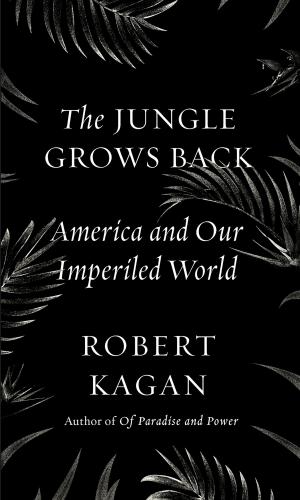
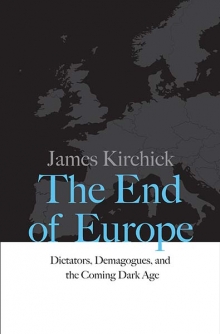
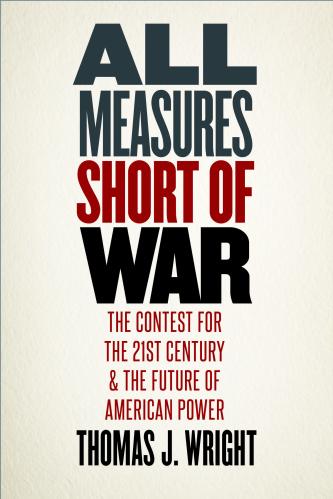
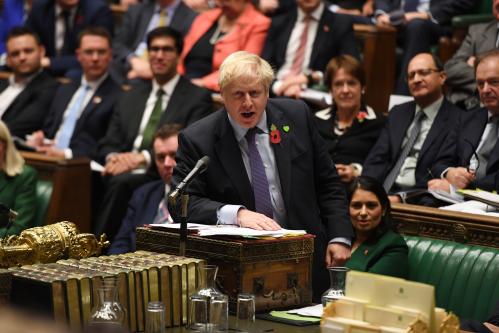
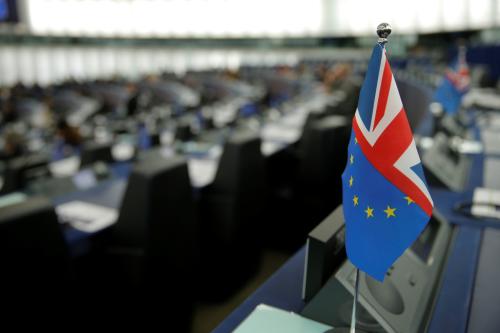
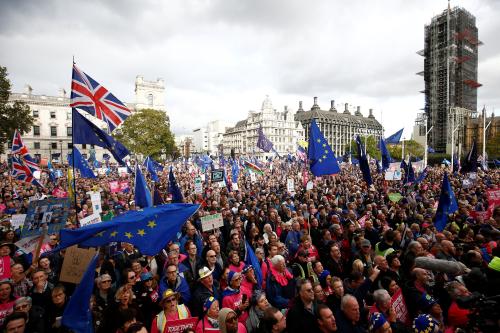

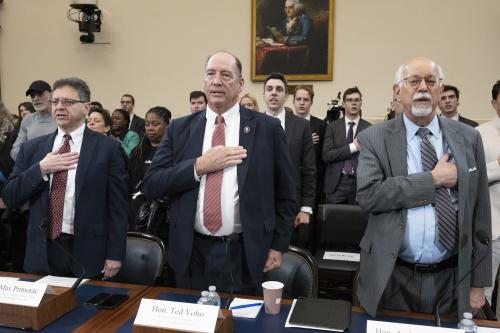
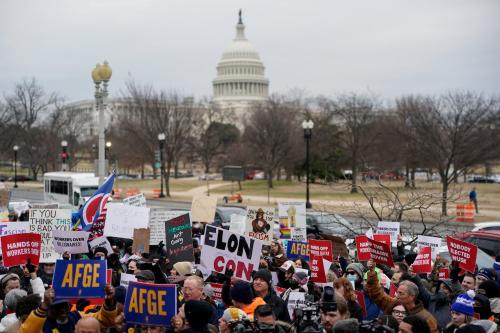
Commentary
Brexit endgame: British voters back Boris and Brexit
December 13, 2019